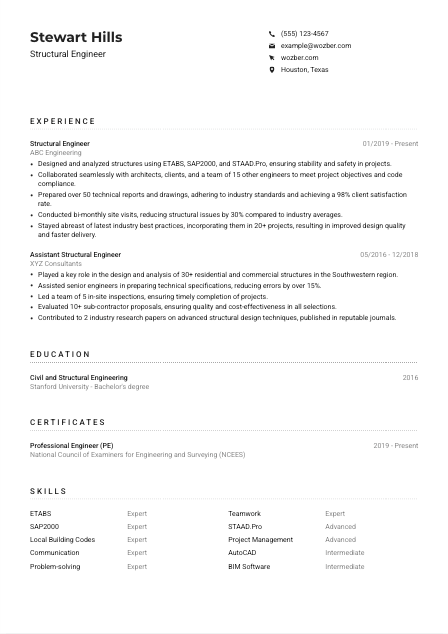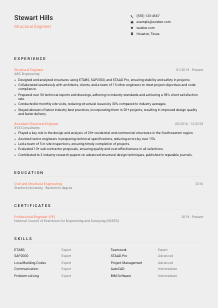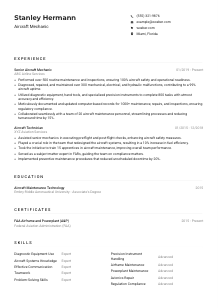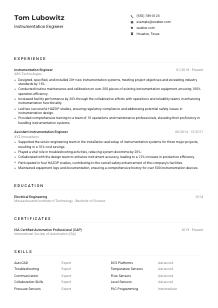Structural Engineer Resume Example
Designing robust frameworks, but your resume feels shaky? Explore this Structural Engineer resume example, engineered with Wozber free resume builder. Grasp how to align your statics-savvy profile with job specifics, setting your engineering career on a foundation as solid as your structures!

How to write a Structural Engineer resume?
As a Structural Engineer, your resume isn't just a summary of your qualifications; it's the blueprint of your professional journey, showcasing your skills, and letting you stand out in the steel framework of the job market. With the fine tools provided by the Wozber free resume builder, including the ATS-compliant resume formats and the invaluable ATS resume scanner, you're about to embark on a journey to construct a resume that not only meets the demands of the job description but is also optimized to sail smoothly through Applicant Tracking Systems. Let's set the foundation for your career success together!
Personal Details
The gateway to your resume, the Personal Details section needs to be more than just accurate; it has to be a concise reflection of your readiness for the Structural Engineer role. Let's cement this section with precision.
1. Your Name as Your Brand
Your name is the keystone of your professional identity. Ensure it's easily noticeable with a clear, legible font. This simple yet powerful step begins your resume on a note of professionalism.
2. Engineering Your Job Title
Aligning with the job title right below your name positions you as an ideal candidate from the get-go. For instance, labeling yourself as a "Structural Engineer" directly connects you to the job at hand.
3. Contact with Precision
Include your phone number and a professional email to ensure potential employers can contact you seamlessly. Double-check each detail for accuracy to maintain the integrity of your introduction.
4. Location Alignment
By specifying that you're based in or willing to relocate to Houston, Texas, you immediately meet one of the job requirements. It's a small detail that emphasizes your alignment with the job's logistical needs.
5. Professional Linkages
If you have a LinkedIn profile or a personal website that showcases your engineering projects or portfolio, do include it. This provides a live demonstration of your abilities and dedication.
Takeaway
This section is your handshake with the hiring manager. Craft it with attention to detail and relevance, ensuring every piece of information is a cornerstone in building the professional image you wish to convey. Let this section set a strong and precise tone for what's to follow on your well-engineered resume. Remember, with Wozber, you're using an ATS-friendly resume template that ensures this essential information is optimally positioned for both human eyes and ATS.





Experience
The Experience section is where your resume really starts to take shape, much like a well-planned infrastructure project. Let's dive deep into how to structure this section to demonstrate your achievements and suitability for the Structural Engineer position.
- Designed and analyzed structures using ETABS, SAP2000, and STAAD.Pro, ensuring stability and safety in projects.
- Collaborated seamlessly with architects, clients, and a team of 15 other engineers to meet project objectives and code compliance.
- Prepared over 50 technical reports and drawings, adhering to industry standards and achieving a 98% client satisfaction rate.
- Conducted bi‑monthly site visits, reducing structural issues by 30% compared to industry averages.
- Stayed abreast of latest industry best practices, incorporating them in 20+ projects, resulting in improved design quality and faster delivery.
- Played a key role in the design and analysis of 30+ residential and commercial structures in the Southwestern region.
- Assisted senior engineers in preparing technical specifications, reducing errors by over 15%.
- Led a team of 5 in‑site inspections, ensuring timely completion of projects.
- Evaluated 10+ sub‑contractor proposals, ensuring quality and cost‑effectiveness in all selections.
- Contributed to 2 industry research papers on advanced structural design techniques, published in reputable journals.
1. Analyzing Job Requirements
Begin by dissecting the job description. Highlight key terms like ‘structural analysis', ‘ETABS, SAP2000, and STAAD.Pro proficiency', ensuring these keywords are reflected in your descriptions without compromising the truth of your experience.
2. Company and Role Structure
Present your career chronologically, emphasizing your roles relevant to structural engineering. For each position, include your title, the company's name, and the employment timeline to provide a clear professional timeline.
3. Engineering Your Achievements
Transform your responsibilities into achievements. Use action-driven language to convey the impact of your work, such as "Designed and analyzed structures, ensuring stability and safety", directly mirroring the job requirements.
4. Quantification of Success
Whenever possible, apply numerical values to your achievements. This could be the number of projects led, percentages of efficiency improvement, or cost reductions. Quantifiable results speak volumes in the engineering world.
5. Relevance and Precision
Focus solely on experiences that sculpt your profile as the ideal Structural Engineer for the job. Extraneous information can dilute the strength of your candidacy, so keep each bullet point relevant and potent.
Takeaway
Think of the Experience section as the framework of your professional edifice. It's about showcasing not just where you have been, but how each step has prepared you for this next leap. Through deliberate structuring and attention to detail, you can craft a narrative as sturdy and compelling as the structures you aim to design. Remember, the ATS-friendly resume format provided by Wozber ensures that your experience is presented in a way that's both appealing to hiring managers and accessible to ATS.
Education
Your educational background lays the groundwork of your expertise in structural engineering. Just as every beam and column in a structure is essential, the way you present your education can significantly impact your resume's strength.
1. Targeted Educational Background
Highlight the essential educational requirement – in this case, a "Bachelor's degree in Civil or Structural Engineering." This directly addresses a primary requirement from the job description, aligning your qualifications with the role.
2. Clear Educational Structure
Arrange this section for clarity: degree, field of study, institution, and graduation date. This clear structure makes it easy for hiring managers and ATS alike to verify your educational credentials.
3. Degree Details
Given the specific demand for a degree in Civil or Structural Engineering, ensure this is accurately reflected on your resume. Match the language of the job description to affirm your eligibility.
4. Highlighting Relevant Courses
If applicable, mention specialized courses that further validate your expertise for the Structural Engineer role. This can be particularly persuasive early in your career when direct experience might be lighter.
5. Additional Academic Achievements
For roles requiring a deep technical foundation, sharing relevant academic achievements or extracurricular involvements can add depth to your educational narrative. Be selective and ensure these details enhance your candidacy.
Takeaway
The Education section of your resume doesn't just list where you've studied; it underlines the foundation of your expertise in Structural Engineering. Use this opportunity to align your educational background directly with the needs of the role, reinforcing your fit for the position. With Wozber's ATS-compliant resume formats, you can be sure that this vital information is presented effectively.
Certificates
In the world of Structural Engineering, certifications can be the reinforcements that distinguish you from other candidates. They show your commitment to continuous learning and adherence to industry standards.
1. Key Certifications
Begin by identifying if the job description explicitly requires any certifications. If not directly stated, consider what certifications would enhance your candidacy based on the responsibilities and requirements outlined.
2. Relevant Certifications Highlight
Listing certifications that are directly relevant to Structural Engineering and the specific job description can significantly bolster your resume. For example, a 'Professional Engineer (PE)' certification directly correlates with the expertise and trustworthiness expected in the role.
3. Transparency in Timing
For each certification, include the date of achievement or recertification to indicate the currency of your knowledge and skills. This adds to your credibility and shows a commitment to staying current in your field.
4. Staying Contemporary
The engineering field is always evolving, and so should you. Actively seek out and add new certifications that align with industry advancements and job requirements, showing your adaptability and eagerness to grow.
Takeaway
By strategically selecting and presenting your certifications, you signal your dedication to the highest standards of Structural Engineering. Each certification is a testament to your skill set and your commitment to professional growth. Wozber's ATS optimization tools ensure these critical qualifications are highlighted effectively, making your resume not just ATS-friendly but irresistible to hiring managers.
Skills
Your skills section is like the load-bearing wall of your resume; it must be constructed with care and precision, supporting the claim that you are the ideal candidate for the Structural Engineer role.
1. Unpacking the Job Description
Mine the job description for both stated and implied skills required for the role. Look for mentions of technical proficiencies like 'ETABS' or 'SAP2000' and soft skills such as 'excellent communication.'
2. Skill Alignment
Match your skills list with those identified from the job description. Prioritize skills where you have solid evidence of your proficiency and accomplishments, ensuring a balance between technical expertise and soft skills.
3. Organized Presentation
Keep this section streamlined and focused. Listing too many skills can dilute the impact of your core competencies. Stick to the most relevant skills that build a compelling case for your candidacy.
Takeaway
Your skill set is a critical component of your resume, providing a snapshot of what you bring to the table. By carefully selecting and presenting your skills, you can paint a picture of a versatile, competent Structural Engineer ready to tackle the challenges of the role. And with Wozber's ATS resume scanner at your disposal, you can ensure that your skills section is optimized for both ATS and the discerning eyes of hiring managers.
Languages
In the diverse field of Structural Engineering, being proficient in multiple languages can be an asset, particularly in areas with multicultural teams or international projects.
1. Checking Language Requirements
First, determine if the job posting specifies any language requirements. For example, fluency in English is a must for the Structural Engineer position we're discussing.
2. Prioritizing Essential Languages
List languages that are directly relevant to the job at the top of your section, clearly indicating your proficiency level. English, in this case, is a must-have, and your proficiency should be clearly stated.
3. Showcasing Additional Languages
Even if not directly required, additional languages can enhance your resume by demonstrating cultural competency and the ability to communicate with diverse teams or clients.
4. Honest Proficiency Levels
Be transparent and accurate about your language proficiency. Clearly state whether you are native, fluent, intermediate, or basic, avoiding any ambiguity.
5. Understanding the Global Aspect
Consider the global scope of structural engineering projects. Your linguistic skills can signify your readiness to engage in projects beyond local horizons, making you a more versatile candidate.
Takeaway
Your linguistic skills are a powerful tool in highlighting your ability to navigate and contribute to diverse work environments. In a profession that often involves collaboration across borders, your language abilities can set you apart. Emphasize your linguistic proficiencies as they relate to your professional adventures, and let them open up even more opportunities for you in the world of Structural Engineering.
Summary
The Summary section is your opportunity to frame the narrative of your resume. Like a well-architected entrance to a building, it invites the reader to explore further. Let's craft a compelling summary that encapsulates your professional identity as a Structural Engineer.
1. Grasping the Job's Core
Begin by thoroughly understanding the job description. Identify the primary skills and experiences the employer is seeking, focusing on how your background aligns with these requirements.
2. Crafting Your Opening Statement
Start with a powerful introduction that positions you as a dedicated and skilled Structural Engineer. Highlight your years of experience and specific areas of expertise that match the job's needs.
3. Highlighting Your Triumphs
Briefly mention key achievements that illustrate your capabilities and impact in past roles. This could include successful projects you've led, innovations you've implemented, or recognition you've received.
4. Conciseness is Key
Keep your summary clear and to the point. In a few, impactful sentences, give the hiring manager a compelling reason to consider you as a top candidate for the Structural Engineer position.
Takeaway
This section is your professional headline, summarizing your experience, skills, and career goals in relation to the job you're seeking. A well-crafted summary can intrigue the hiring manager and encourage them to delve deeper into your resume. As you piece together your summary, remember the importance of ATS optimization to ensure that your resume reaches the right hands. With Wozber, you have all the tools necessary to create an engaging, ATS-friendly resume that stands out.
Constructing Your Path Forward
Equipped with these detailed guidelines and the powerful tools provided by Wozber, you're now ready to build a resume that not only meets the specifications of a Structural Engineer position but also showcases your unique abilities and achievements. Remember, in a field that values precision, your resume is a reflection of your professional standards. Utilize Wozber's free resume builder, ATS-friendly resume templates, and ATS resume scanner to ensure your application is as strong and structured as the projects you're passionate about. Step into the future with confidence; your next opportunity is just a well-crafted resume away.

- Bachelor's degree in Civil or Structural Engineering from an accredited institution.
- Minimum of 4 years of professional experience in structural analysis, design, and evaluation.
- Proficiency in using software tools such as ETABS, SAP2000, and STAAD.Pro.
- Strong understanding of local and national building codes and regulations.
- Excellent communication skills, both written and verbal, with the ability to collaborate effectively with multidisciplinary teams.
- Must have the ability to converse fluently in English.
- Must be located in or willing to relocate to Houston, Texas.
- Design and analyze structures using software tools and manual calculations to ensure stability and safety.
- Prepare technical reports, drawings, and documentation for projects, adhering to industry standards and client requirements.
- Collaborate closely with architects, clients, and other engineers throughout the project lifecycle to meet project objectives and quality standards.
- Conduct periodic site visits to assess structural integrity and address any design or construction-related issues.
- Stay updated with industry advancements, best practices, and code revisions to ensure compliance in all projects.















